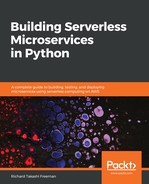The drawback of the monolithic architecture is that there is usually a single technology stack. This means the application server or the web server or the database frameworks are consistent throughout the enterprise. Obsolete libraries and code can be difficult to upgrade, as this is dependent on a single stack and it's almost like all the services need to be aligned on the same version of libraries.
Another drawback is that the code base is usually very large on a single stack stack, which means that there are long build times and test times to build and deploy the code. The services are deployed on a single or a large cluster of application servers and web servers. This means that, in order to scale, you need to scale the whole server, which means there's no ability to deploy and scale applications independently. To scale out an application, you need to scale out the web application or the application server that hosts the application.
Another drawback is that there's generally a middleware orchestration layer or integration logic that is centralized. For example, services would use the Business Process Management (BPM) framework to control the workflow, you would use an Enterprise Service Bus (ESB), which allows you to do routing your messages centrally, or you'd have some kind of middleware that would deal with the integration between the services themselves. A lot of this logic is tied up centrally and you have to be very careful not to break any inter-service communication when you're changing the configuration of that centralized logic.
